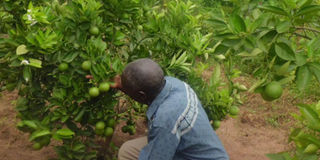How to manage deadly fruit flies

A farmer in Mubende looks out for defects on his oranges. Citrus farmers need to be aware of fruit flies. Photo by Lominda Afedraru.
The horticulture sector in the country is confronted by a number of challenges including pests and diseases. The fruit sector in particular is affected by the fruit fly and farmers are expected to adopt integrated management practices
This is to enable ample yields to supply the local and export market in the region since there is still room for investment in the fruit processing sector. However, farmers are faced with the challenge of fruit flies which destroy fruits during the process of growing leading to yield loss.
As such scientists at the National Agricultural Research Laboratories (NaRL) in Kawanda have come up with the alternative ways of controlling the fruit flies other than spraying with chemicals which may end up destroying the fruits.
Seeds of Gold got the opportunity to interact and interview Ms Florence Nampira, a research technician at the institute and below are the details.
Fruit fly management Nampira explained that the major fruit fly which destroys fruits such as mangoes, avocado, among others, is orient fruit fly (Bactrocera dorsalis) causing loss in mango fruits from 30-80 per cent if not controlled.
In most cases it is the female ones which destroys the fruits by piercing it with its ovipositor where it lays eggs which hatch in the fruit growing into a larva. The larva feeding caused premature ripening and fruit dropping from the tree.
Once the larva emerges from the fruit and it falls on the ground, pupation occurs in the soil beneath the host plant and in 10 days it becomes an adult and the cycle continues.
Control measures
Orchard sanitation is the first thing a farmers is expected to practice by disrupting the life circles of the fruit fly. This can be by destroying all fruits containing the larva by burying them or putting them in plastic bags to suffocate the eggs and larva.
Mass trapping
This is where Male Annihilation Technique (Mat) blocks are made out of a mixture of methyl eugenol and malathion impregnated bait stations which are tied on the jerrycan containing water. It is advisable to put holes at the bottom of the trap to allow water to escape.
The trap is tied using strings which are hanged on the tree. One Mat block will last for four months meaning it will keep trapping the flies and once the jerrican is full a farmer is expected to pour and empty it. This treatment should be repeated every six to eight weeks.
Bagging of fruits
Here farmers are expected to purchase envelopes which they can use to bag the mangoes. Ensure the envelopes are stapled on the sides to keep it firm and this should be done early before the fruits begin to ripen.
Other management practices include pruning and early harvesting when the fruits are still hard to prevent piercing by the female fruit fly.
Ploughing by raking the top soil 5- 10cm deep at the tree basin at frequent intervals to expose the larva and pupa to the sun or to predators such as birds, is another good practice. Farmers may also use recommended chemicals which are friendly to the fruits thereby not causing any damage to the fruit of health hazard to consumers. andUpon harvest farmers must ensure the fruit is thoroughly washed before it is taken to the market for sale.
These management practices cut across all fruit species which stand at danger of being destroyed by fruit flies. According to Nampira they have been sensitising farmers on these management practices since 2010 and many in the districts of Budaka, Masaka, Nwoya, Nakaseke and Iganga have since taken it on, leading to improved yields.
Bait spraying
This is where farmers are expected to mix a fruit bait with an insecticide which is sprayed to the tree leaves and trunks at weekly intervals. At the moment the baits are imported but farmers can improve by mixing fruit pulp with insecticide which they can spray using same method
This, according to the scientists, has an advantage of a minimum amount of insecticide as opposed to the conventional spraying where the whole plant has to be sprayed.




